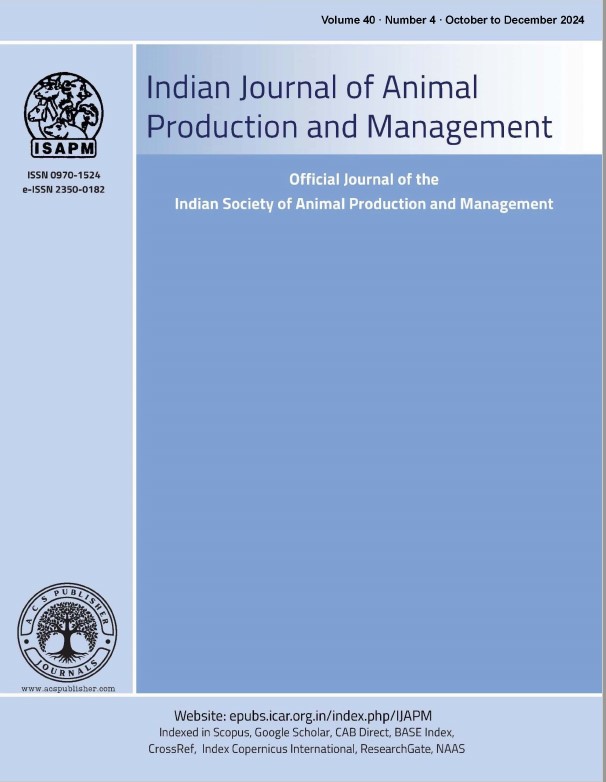Effect of Nano Vitamin E and Selenium Supplementation on Serum Biochemical Profile in Japanese Quails
DOI:
https://doi.org/10.48165/ijapm.2023.37.4.11Keywords:
Nano vitamin E, Selenium, Japanese quails, serum biochemistryAbstract
This study investigated the impact of nano vitamin E with Selenium on serum parameters in Japanese quails. The experiment involved three groups: a control group (C1) fed a basal diet, a T1 group receiving vitamin E (150mg/kg) and Selenium (0.3mg/kg), and a T2 group receiving nano vitamin E (15mg/kg) and Selenium (0.03mg/kg). Results revealed significant differences (p<0.05) in serum analyses among the groups. The T2 group showed the highest total protein and globulin levels, while the T1 group exhibited the highest total albumin levels. Total cholesterol levels were significantly lower in the T2 group, with the highest HDL cholesterol. LDL cholesterol levels were lower in the T2 group. SGOT and SGPT levels were significantly lower in the T2 group. These findings suggest the potential benefits of nano vitamin E with Selenium in modulating serum biochemistry in Japanese quails.
References
Alagawany, M., Qattan, S. Y., Attia, Y. A., El Saadony, M. T., Elnesr, S. S., Mahmoud, M. A., & Reda, F. M. (2021). Use of chemical nano-selenium as an antibacterial and antifungal agent in quail diets and its effect on growth, carcasses, antioxidant, immunity and caecal microbes. Animals, 11(11), 3027.
Aljumaily, A. S. A., & Aljumaily, T. K. H. (2021, April). The effect of the addition of nano selenium and vitamin E on productive performance and the characteristics of the physical and chemical carcass of broilers. In IOP Conference Series: Earth and Environmental Science (Vol. 735, No. 1, p. 012017). IOP Publishing.
Elaroussi, M. A., Fattah, M. A., Meky, N. H., Ezzat, I. E., & Wakwak, M. M. (2007). Effects of vitamin E, age and sex on performance of Japanese quail. 1. Haematological indices and liver function. British poultry science, 48(6), 669-677.
Goel, A., Ncho, C. M., Gupta, V., & Choi, Y. H. (2023). Embryonic modulation through thermal manipulation and in ovo feeding to develop heat tolerance in chickens. Animal Nutrition.
Gouda, A., El-Wardany, I., Hemid, A. A., El Moniary, M. M. A., & Eldaly, E. F. (2015). The effect of dietary supplementation of organic chromium, organic selenium and vitamin E on physiological responses in broilers under natural summer conditions. Egyptian Journal of Nutrition and Feeds, 18(2 Special), 263-274.
Habibian, M., Ghazi, S., Moeini, M. M., & Abdolmohammadi, A. (2014). Effects of dietary selenium and vitamin E on immune response and biological blood parameters of broilers reared under thermoneutral or heat stress conditions. International journal of biometeorology, 58, 741-752.
Imik, H., Ozkanlar, S., Kaynar, O., & Koc, M. (2009). Effects of vitamin E, C, and α-lipoic acid supplementation on the serum glucose, lipid profile, and proteins in quails under heat stress. Bulletin of the Veterinary Institute in Puławy, 53(3), 521-526.
Ismail, F. S. A., El-Gogary, M. R., & El-Nadi, M. I. (2014). Influence of vitamin E supplementation and stocking density on performance, thyroid status, some blood parameters, immunity and antioxidant status in broiler chickens. Asian Journal of Animal and Veterinary Advances, 9(11), 702-712.
Mobaraki, M. A., Shahryar, H. A., & Dizaji, A. A. (2013). The effects of vitamin E-Se supplemented on some of serum biochemical parameters in the laying Japanese quail. Bulletin of Environment, Pharmacology and Life Sciences, 2(10), 29- 32.
Mohapatra, P., Swain, R. K., Mishra, S. K., Behera, T., Swain, P., Mishra, S. S., ... & Jayasankar, P. (2014). Effects of dietary nano-selenium on tissue selenium deposition, antioxidant status and immune functions in layer chicks. International Journal of Pharmacology, 10(3), 160-167.
Singh, C. D., Gohain, A. K., Bhuyan, R., Dixit, C. P., & Haloi, S. (2020). Effect of supplementation of certain antioxidants (Vitamin E, vitamin C and selenium) on the growth performance of broiler chicken during heat stress. Journal of Entomology and Zoology Studies, 8(6), 2066-2071.

